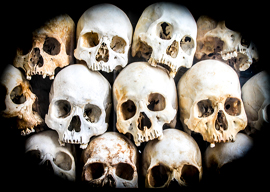
April 30, 2016

Source: Bigstock
Aleksandr Solzhenitsyn said of William Shakespeare, the 400th anniversary of whose death has just passed, that he was capable of writing tragedies only about individuals, or small groups of individuals, because he lived at a time without ideology. The latter was necessary for killing on a mass scale, Solzhenitsyn said. Two years after Shakespeare died, the Thirty Years” War broke out, which reduced the population of Germany by about a third. The war was ideological.
Solzhenitsyn also said that the dividing line between good and evil ran through every heart. This is not a contradiction: Ideology encourages or makes easier the commission of evil.
The propensity to do good or evil no doubt varies between individuals for inborn reasons; but that propensity follows, or at least can be conceived as following, a normal distribution, a bell-shaped curve. At the extremes of the distribution are saints and monsters, the vast majority of us lying somewhere in between; but the whole distribution can be shifted in the direction of good or evil by circumstances, among which is the prevalent ideology. When the bell-shaped curve shifts in the direction of evil, disproportionate numbers of monsters emerge who do things that, at other times and in other places, they would not do.
“There can be no greater pleasure in life,” Stalin is reputed to have said, “than to choose one’s enemy, inflict a terrible revenge on him, and go quietly to bed.” He might have added, if he really did say this, “secure in the knowledge that one has done good.” Committing evil for goodness” sake must surely rank as an even greater pleasure than Stalin’s: It satisfies the inner sadist and the inner moralist at the same time.
That is why beheading in the Middle East (and recently in the Philippines) is such fun for those who do it. The latest reported outrage is the freezing to death by ISIS of 45 of their fighters who retreated, or ran away, before the advance of Iraqi forces; ISIS is alleged to have put the men into a freezer in a forensic morgue in Mosul and then put the bodies by the roadside as a warning to other would-be cowards. For myself, I was a little surprised that as sophisticated an institution as a forensic morgue was still in existence and still functioning in the Islamic state.
As the only source of this story so far is the Iraqi government news agency, which might not be wholly committed to the truth, we should exercise a degree of skepticism toward it. Atrocities are committed, all right, but stories about atrocities are also sometimes made up for propaganda purposes. If the story is untrue, it suggests that somebody has a sadistic imagination.
I was interested in the commentary by readers left on sites that reported the story. Here is a short selection:
Blow em all to hell. Take no prisoners.
Just kill every one of them and rid them of our world! No place for those kind of suppose to be humans. I cannot imagine how anyone human can be so inhuman.
They should all go in the freezer.
Kill them all save us the trouble.
We must exterminate them all. No other way.
I hope they all die the sick bastards!
This last comment was left by someone who described herself as a professional carer, the caring professions being far from entirely alien to sadism, though it is usually committed (by those so inclined) on a small scale”such as making the cared-for wait longer than necessary”to evade detection by supervisors.